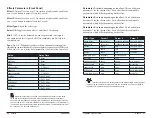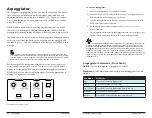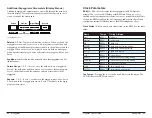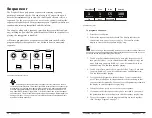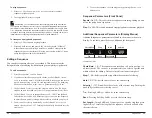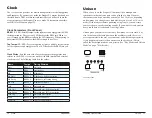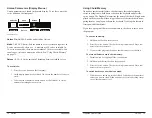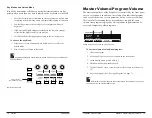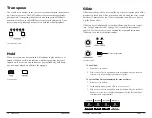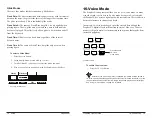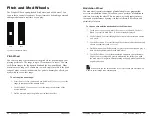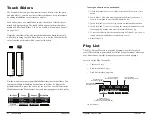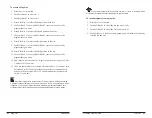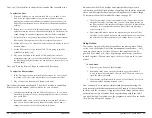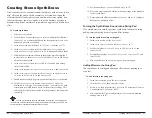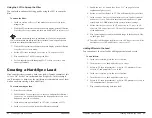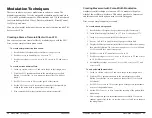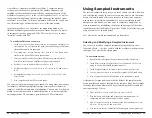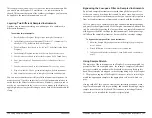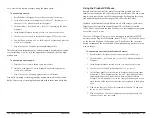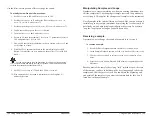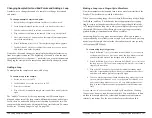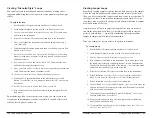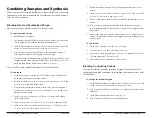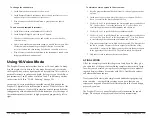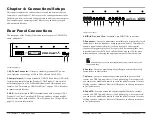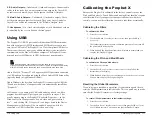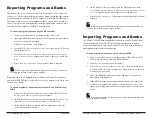
88
89
Synthesis 101: Synth Bass
Sequential
Prophet X User’s Guide
Synthesis 101: Synth Bass
Next, you’ll use the filter to shape the raw sound of the sawtooth wave.
To adjust the filter:
1.
Press and hold down a key and turn the filter’s
cutoff
knob. Notice
how it cuts the high frequencies as you rotate counter-clockwise,
making the sound of the oscillator less bright. If you turn the
cutoff
knob fully counterclockwise you’ll filter out all frequencies and hear
nothing.
2. Return the
cutoff
knob to its halfway position, play and hold a note
again then turn the
resonance
knob about halfway up. Notice how the
sound changes as a band of frequencies near the cutoff is amplified.
3.
Rotate the filter’s
cutoff
knob again and you’ll hear a classic resonant
filter sweep. You’re going to use this to create your synth bass.
4.
Set the filter
cutoff
to a value of 40 (refer to the main display to see its
numeric value).
5.
Set the filter
resonance
to a value of 100. This is going to give the
synth bass its funky “zap.”
6. Play a note and listen to the sound. At this point you won’t hear
anything because you’ve mostly closed the filter. You’ll need to open
the filter using the filter envelope (so you don’t have to turn the
cutoff
knob by hand).
Now, you’ll use the filter envelope to control the filter sweep.
To adjust the filter envelope:
1. In the Envelopes section, turn the Filter Envelope’s
env
amount
knob
to a value of 50 (refer to the main display to see its numeric value).
2. Play a low note on the keyboard. Instant synth bass!
Notice how the sound has changed. The Filter Envelope is controlling
filter cutoff by the amount you set with the
env
amount
knob.
3. Continue experimenting with the Filter Envelope’s
env
amount
knob.
Notice how greater
env
amount
settings amplify the effect of the enve-
lope on the filter.
4. Repeatedly strike a note on the keyboard as you turn the Filter Enve-
lope’s
decay
knob clockwise and counterclockwise. Notice how it
changes the sound as the note decays faster or slower.
Be aware that the Filter Envelope and Amplifier Envelope work in
conjunction, with the Filter Envelope controlling how the filter opens and
closes and the Amplifier Envelope controlling the overall volume shape.
To learn more about the Amplifier Envelope, see
page 42.
5. The Filter Envelope’s
release
parameter acts in conjunction with the
Amplifier Envelope. In other words, you can’t hear a long release on
the filter envelope if the amplifier envelope is short! So to hear the filter
envelope’s
release
parameter in action, first set the Amp Envelope’s
release
value to 75.
6. Now repeatedly strike a note on the keyboard as you turn the Filter
Envelope’s
release
knob clockwise and counterclockwise. Notice how
the note fades out faster or slower as you change the
release
value.
Using Unison
You can use Unison to thicken the synth bass sound even more. When
unison
is on, the Prophet X acts like a monophonic synthesizer — only
one note can be played at a time. However, that single note can be
powered by as many as 8 voices, depending on how many you choose
to stack together. (You can stack up to 16 voices if you are in 16-voice
mode.)
To use Unison:
1. Press the
unison
button on the front panel.
2. Repeatedly strike a note on the keyboard as you use Soft Knob 2
(
mode
) to choose the number of voices to stack. The more voices you
stack, the denser the sound.
3. To detune the oscillators while in unison, use Soft Knob 3 (
detune
) to
set the amount of detuning between voices.
Now you know how to create a simple synth bass program using the
most essential synthesizer components of the Prophet X: the oscillators,
the filter, and the envelopes. Using just these three things you can create
an enormous variety of sounds. Keep experimenting with them and if
you like what you’ve created, save the programs in one of the user banks.
(See “Saving a Program” on page 7.)

